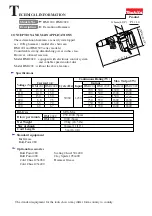
64
GMC-I Messtechnik GmbH
SRQ
is also reset.
*TRG – Device Trigger Function
Functions
Triggering of functions specified with
*DDT
Programming
Setting command:
*
TRG
Example
(HP Basic
):
OUTPUT 713;"*TRG"
Note
If DDT memory is empty, the trigger function is considered
undefined. When the *TRG command is received, bit 4 (EXE,
execution error) is immediately set in the standard event register.
The *TRG command may not be used as part of the *DDT
command. Execution of the *TRG command does not change the
DDT register.
*TST? – Starting the Self-Test
Functions
Command for a
device self-test
Test results
are written to the
output buffer
as a response.
The self-test has
no effect
on current
device settings
or stored
parameters.
The self-test is started immediately after receipt of the
corresponding query command and has a duration of
approximately
6 seconds
.
Programming
Query command:
*TST?
Response string:
0 = test passed
1 = error detected
Length: 1
character,
fixed
Notes:
As long as the test is running, no data can be transmitted to the
device and manual operation is disabled.
Do not transmit the *TST? command together with other setting and/
or query commands in a single string.
Enter a waiting period of approximately 6 seconds between
transmission of the query command and read-out of the response
string.
IEC bus control:
Completion of the self-test can be recognize by
means of cyclical querying and evaluation of the status byte
(
serial polling
) (
test completed —> MAV-Bit = 1
).
The
self-test is not influenced
by
serial polling
.
If the self-test is failed, the
TSTE
bit is set in
ERB
(event register
B).
If appropriate
masking
is implemented with event registers
ERDE
and
SRE
, an
SRQ message
is triggered.
*WAI – Wait to Continue
Functions
The
*WAI
command is of no significance for programming the
KONSTANTER. It serves to synchronize the interface protocol in
accordance with the IEC 488.2 standard.
ADDRESS – Interface Addressing
Function and manual operation:
See explanation in chapter 4.7.
Programming
Setting command:
ADDR
ESS
n
Parameter:
n
(address number)
Parameter type:
Integer (whole number)
Setting range:
0
n
30, 31 (= UNL
unlist)
Example
:
"ADDRESS 13"
Comments
If the SSP KONSTANTER is operated at the
serial interface
only,
sub-addressing can be omitted.
If the SSP KONSTANTER is operated at the
optional IEEE488
interface
, sub-addressing is ignored.
CRA? – Condition Register Query
Query
Functions
Condition register A (see also chapter 6.3 on page 60 and the
table: “Query Commands for Status and Events Management”
on page 86).
8 bit status register
Current status of a certain device function at the point in time
of the query
Direct writing and clearing is not possible.
Example
– Output in current regulating mode (
CCR
):
CCR
status bit 1 is set (= 1) in the
CRA
.
– The status bit remains set for the duration of current
regulation.
– CRA can be queried as often as desired.
– The contents of the CRA are not changed by the query.
– The current regulating mode is exited:
CCR
status bit 1 is reset (= 0) in the
CRA
.
Programming
Query command:
CRA?
Response string:
n (
decimal equivalent
)
Value:
0
n
255
Length:
3 characters, fixed
Example (HP Basic):
OUTPUT 713; "CRA?"
ENTER 713; A$; DISP A$
Display:
002 {002
10
= 0000 0010
2
}
(CCR, constant current regulation)
Summary of Contents for SSP 120 Series
Page 2: ...2 GMC I Messtechnik GmbH ...
















































